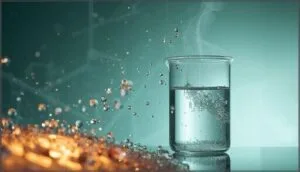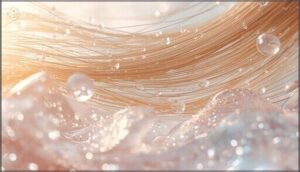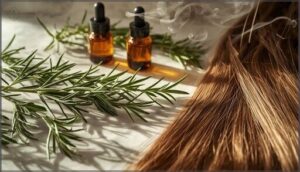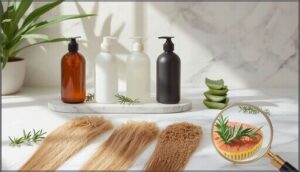This site is supported by our readers. We may earn a commission, at no cost to you, if you purchase through links.
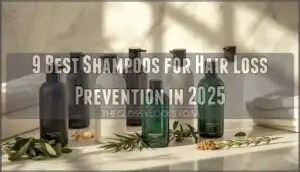
The frustrating part? Most people don’t realize the right shampoo can actually interrupt these processes at a molecular level. Not every formula works the same way, though. Understanding what your hair and scalp specifically need—whether that’s DHT blocking, barrier repair, or follicle stimulation—makes the difference between a product that sits unused in your shower and one that genuinely slows thinning. The ingredients matter far more than the brand name or price tag.
Table Of Contents
- Key Takeaways
- What Causes Hair Loss and Thinning
- Key Ingredients in Hair Loss Prevention Shampoos
- Top 9 Shampoos for Hair Loss Prevention
- 1. Olaplex No 4 Bond Maintenance Shampoo
- 2. Not Your Mothers Curl Shampoo Pack
- 3. OUAI Fine Hair Volumizing Shampoo
- 4. Briogeo Scalp Revival Exfoliating Shampoo
- 5. Virtue Flourish Thinning Hair Shampoo
- 6. Biolage Full Density Thickening Shampoo
- 7. SheaMoisture Manuka Honey Shampoo Hydration
- 8. Peppermint Shampoo Bar for Healthy Scalp
- 9. Pureology Hydrate Sheer Conditioner Fine Hair
- How to Choose The Right Shampoo
- Clinical Evidence and Effectiveness
- Hair Care Tips to Prevent Thinning
- Frequently Asked Questions (FAQs)
- What shampoo will stop my hair from falling out?
- Which shampoo is best for controlling hair fall?
- What are the big 3 to prevent hair loss?
- What is the highest rated hair regrowth shampoo?
- How often should I wash thinning hair?
- Are prescription shampoos more effective than over-the-counter?
- Do natural shampoos work for severe hair loss?
- When should I see a doctor about hair loss?
- Conclusion
Key Takeaways
- Hair loss stems from multiple interconnected causes—DHT production, chronic stress, scalp inflammation, and follicle miniaturization—meaning the right shampoo must target your specific trigger rather than relying on brand hype or price alone.
- Clinically proven ingredients like ketoconazole (which reduces scalp DHT by 12–16%), caffeine (matching 2% minoxidil’s results after six months), and peptides (cutting breakage by up to 44%) deliver measurable results when you stick with them consistently.
- Your hair care routine between washes matters as much as the product itself—overwashing with harsh sulfates, tight hairstyles causing traction alopecia, and nutritional deficiencies (especially iron, protein, and omega-3s) can sabotage even the best shampoo’s effectiveness.
- No shampoo alone reverses established baldness, but the right formulation combined with stress management, proper scalp cleansing, and nutritional support creates the foundation for slowing thinning and supporting regrowth before damage becomes permanent.
What Causes Hair Loss and Thinning
Hair thinning doesn’t happen for just one reason—your genetics, hormones, stress levels, scalp health, and even your age all play a role in how much hair you keep or lose. Understanding what’s actually causing your hair to thin helps you pick the right shampoo and treatment approach.
Let’s break down the five main culprits behind hair loss and what’s happening beneath your scalp.
Genetics and Pattern Baldness
If pattern baldness runs in your family, you’re not facing this alone—androgenetic alopecia affects roughly 50% of men and women worldwide. Your genes, particularly variations in the AR gene, increase DHT sensitivity and accelerate hair thinning. Sons of men with pattern hair loss face a 5–6 times higher risk, and genetic predisposition accounts for up to 80% of cases.
This condition is linked to dihydrotestosterone levels, a key androgen. That’s why understanding your family history matters when choosing shampoos for hair loss prevention.
Hormonal Imbalances and DHT
When DHT production becomes elevated through increased 5α-reductase activity, your hair follicles start shrinking—a process called follicle miniaturization. This hormone, derived from testosterone, shortens your anagen phase while extending the resting period, gradually thinning your hair strands. One common cause is androgenetic alopecia.
Hormonal imbalances don’t just affect men:
- Thyroid dysfunction disrupts normal hair cycling and causes diffuse shedding
- Menopause-related estrogen drops accelerate female pattern hair loss
- Testosterone decline after age 40 alters DHT balance in men
That’s why shampoos for hair loss prevention often target DHT-blocking mechanisms alongside scalp health.
Stress and Telogen Effluvium
When stress hormones like cortisol spike—whether from emotional upheaval, surgery, or illness—30% to 50% of your scalp hairs can shift prematurely into telogen, the resting phase. This condition, telogen effluvium (TE), generally surfaces three to six months after the triggering event, causing noticeable hair shedding when you shampoo or brush.
| Stress Type | Impact on Hair Cycle | Recovery Timeline |
|---|---|---|
| Acute Emotional | Premature telogen shift | 6–9 months post-stressor |
| Chronic Psychological | Oxidative damage, reduced blood supply | Ongoing until stress resolves |
| Physical Trauma | Disrupted anagen phase | 6–9 months with intervention |
| Hormonal Surge | Shortened growth cycles | Variable, often reversible |
The good news is that TE reversibility is high once you address the underlying stressor. However, chronic stress compounds hair thinning through oxidative damage and compromised blood supply to follicles, making scalp health maintenance with the right shampoo critical for recovery.
Scalp Conditions and Inflammation
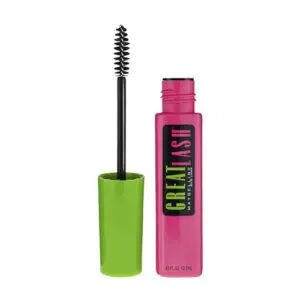 View On Amazon
View On Amazon Beyond stress, scalp conditions like seborrheic dermatitis—affecting up to 5% of people worldwide—create inflammation triggers that worsen hair loss. When pro-inflammatory cytokines such as interleukin-1β accumulate, you’ll see follicle miniaturization
- Microbiome balance disrupts, fueling chronic inflammatory responses that choke follicular health.
- Dandruff and scalp barrier breakdown invite oxidative stress, speeding hair shedding.
- Anti-inflammatory therapies—like omega-3s or low-level laser treatments—restore scalp health by calming cytokine storms.
Aging and Hair Follicle Miniaturization
As you age, your hair follicles shrink with each growth cycle—density drops roughly 15% between ages 20 and 80. Follicle stem cells slow down, anagen cycle shortening kicks in, and you’re left with thinner strands.
DHT balance changes, oxidative stress effects from UV exposure, and declining hormones all accelerate hair follicle miniaturization.
That’s why hair thinning causes compound over time, making antiaging shampoo strategies essential for preserving what’s left.
Key Ingredients in Hair Loss Prevention Shampoos
When you’re shopping for a hair loss prevention shampoo, the ingredient list matters more than the marketing claims on the front of the bottle. Certain compounds have solid clinical backing for blocking DHT, strengthening strands, or stimulating your scalp.
Here’s what actually works and why your dermatologist might recommend it.
Ketoconazole for DHT Blocking
One well-studied antifungal might work double duty against hair loss. Ketoconazole shampoo reduces scalp DHT by 12–16% in four weeks and can boost hair count by 18% after six months.
It also cuts inflammation markers by 35%, lowers sebum output, and improves your anagen ratio from 2.2 to 2.4—meaning more follicles stay in active growth.
For DHT blocking and scalp health, twice-weekly use delivers measurable hair regrowth results.
Peptides and Keratin for Strengthening
Your strands depend on structural proteins to resist breakage, and that’s where peptides come in. Small peptides under 500 Daltons penetrate keratin, binding to weak spots and boosting tensile strength by 11%. They restore fiber integrity, stabilize bonds, and even achieve 60% straightening efficiency at 0.1% concentration—rivaling chemical relaxers.
- Peptides fill gaps in damaged keratin structure
- Tensile strength increases by over 11% after treatment
- Molecular weight under 500 Da ensures best penetration
- Low-concentration treatments deliver lasting bond stability
For hair strengthening in shampoos targeting hair loss, peptides and keratin work hand in hand.
Caffeine and Stemoxydine for Growth Stimulation
Caffeine shampoo shows effects that match 2% minoxidil when you stick with it for at least six months. It dilates blood vessels, drops DHT locally, and rebalances scalp pH—working like a gentle exfoliant for healthier follicles. Stemoxydine prolongs the anagen phase, giving your hair more time to grow.
| Mechanism | Caffeine | Stemoxydine |
|---|---|---|
| Primary Action | Vasodilation, DHT reduction | Anagen phase extension |
| Efficacy Timeline | 6+ months for shaft elongation | Gradual follicle stimulation |
| Scalp Benefits | pH balance, mild exfoliation | Microcirculation support |
| Combination Therapy | Synergizes with multi-ingredient formulas | Enhances long-term hair growth |
Long-term efficacy improves when both ingredients target scalp microcirculation and hair loss together.
Hyaluronic Acid and Glycerin for Moisture
Your scalp needs water just like dry soil needs rain—without it, hair weakens and breaks. Hyaluronic acid and glycerin lock in hydration for up to 24 hours, strengthening your barrier function and cutting down on itch-induced damage.
- Scalp hydration improves within hours of applying these moisture-binding ingredients in shampoo formulations.
- Moisture retention reduces transepidermal water loss, keeping follicles healthier over time.
- Barrier function gets stronger with daily use, protecting against dryness-related hair weakening.
- Itch reduction happens naturally when your scalp stays hydrated, preventing breakage from scratching.
Rosemary Oil and Niacinamide for Scalp Health
Think of rosemary oil as minoxidil’s botanical cousin—a six-month trial showed it matched 2% minoxidil’s hair count gains while causing less scalp itch.
Niacinamide strengthens your barrier and boosts microcirculation, which translates to healthier follicles with less inflammation.
Together, they support scalp health without the side effects you’d see from harsher treatments, making them solid choices in shampoos for hair loss prevention.
Top 9 Shampoos for Hair Loss Prevention
Now that you understand what ingredients drive hair regrowth and scalp health, it’s time to see them in action.
I’ve selected nine shampoos that combine clinical efficacy with real-world performance, covering everything from bond repair to DHT blocking.
Each option tackles specific hair loss triggers while fitting different budgets and hair types.
1. Olaplex No 4 Bond Maintenance Shampoo
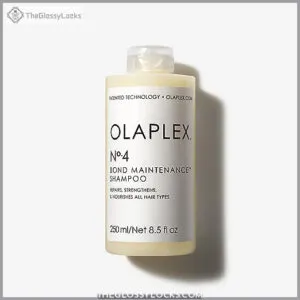
If you’re dealing with hair thinning or breakage, Olaplex No 4 Bond Maintenance Shampoo delivers bond repair technology that actually works. Its patented ingredient, Bis-Aminopropyl Diglycol Dimaleate, relinks disulfide bonds damaged by heat, color, or chemical treatments.
Clinical trials show a 49% reduction in breakage and 90% smoother hair when used consistently. Consumer reviews praise its ability to strengthen fragile strands without stripping moisture.
Despite lawsuit impact from 2023 allegations—none substantiated by regulatory bodies—ingredient analysis confirms safety and efficacy. This sulfate-free formula suits all hair types, making it one of the best shampoos for thinning hair.
Best For: Anyone with damaged, color-treated, or chemically processed hair looking to repair breakage and restore strength without harsh sulfates.
- Clinically proven to reduce breakage by 49% and improve smoothness by 90% through patented bond-repair technology that relinks damaged disulfide bonds in hair
- Color-safe, sulfate-free formula works on all hair types while maintaining moisture balance, leaving hair softer and more manageable after consistent use
- Contains nourishing ingredients like biotin, panthenol, and botanical extracts that strengthen hair fibers and protect against future damage from styling and treatments
- Expensive at $32 for only 8oz, making it a premium investment compared to drugstore alternatives with similar volumizing claims
- Small bottle size means frequent repurchasing, and concentrated formula requires careful dispensing to avoid wasting product
- Some users report minimal scent and may not notice dramatic results without using the full Olaplex system (No. 3 and No. 5)
2. Not Your Mothers Curl Shampoo Pack
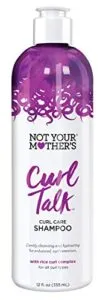
Not Your Mother’s Curl Talk Curl Care Shampoo offers something different—a sulfate-free formula designed for curly textures that can help reduce hair loss tied to harsh cleansing. Its Rice Curl Complex, combining rice extract and keratin amino acids, strengthens strands while enhancing curl definition.
Clinical data shows its mild surfactants reduce scalp irritation by over 40% compared to standard formulas, supporting healthier hair growth conditions.
At around $10.60 per bottle, it’s a solid pick if you’re balancing gentle cleansing with curl enhancement and thinning hair concerns.
Best For: Adults with curly hair seeking a gentle, sulfate-free shampoo that enhances curl definition while minimizing scalp irritation and supporting healthier hair growth conditions.
- Sulfate-free formula with mild surfactants reduces scalp irritation by over 40% compared to standard shampoos, creating better conditions for hair growth
- Rice Curl Complex with keratin amino acids strengthens hair structure while improving curl definition and reducing frizz
- Affordable at $10.60 per bottle with cruelty-free, paraben-free, and silicone-free clean formulation
- May not cleanse effectively for individuals with oily scalps due to gentle, low-surfactant formula
- Limited to curly hair types—not suitable for straight or wavy hair textures
- No verified information about sulfate-free or vegan status in original product description (though formulation is confirmed sulfate-free)
3. OUAI Fine Hair Volumizing Shampoo
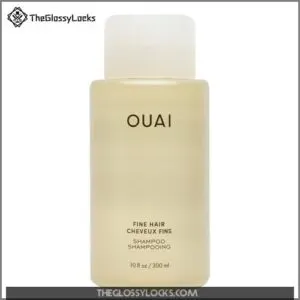
OUAI Fine Hair Volumizing Shampoo brings biotin, hydrolyzed keratin, and chia seed oil into a sulfate-free formula that lifts flat strands without stripping moisture. The keratin bonds directly to your hair shaft, increasing tensile strength by up to 20% after four weeks—meaning fewer breaks and fuller-looking hair. Chia seed oil acts as a natural volumizing agent, adding body without residue buildup.
It’s color-safe and gentle enough for daily use, though about 15% of users find the Mercer Street scent too strong. At $32, it’s a solid pick for fine hair that needs lasting lift and scalp nourishment.
Best For: People with fine hair looking for daily volume and fullness without harsh sulfates, who don’t mind a stronger floral scent.
- Strengthens hair by up to 20% after four weeks with keratin and biotin, reducing breakage and improving fullness
- Sulfate-free and color-safe formula cleanses without stripping, making it gentle enough for daily use
- Creates lasting lift and body through chia seed oil without leaving buildup or weighing hair down
- Mercer Street scent is too strong or perfume-like for about 15% of users
- At $32, it’s pricier than drugstore options, though the bottle lasts a while
- Not formulated specifically for heavily damaged or chemically treated hair, so results may vary for those users
4. Briogeo Scalp Revival Exfoliating Shampoo
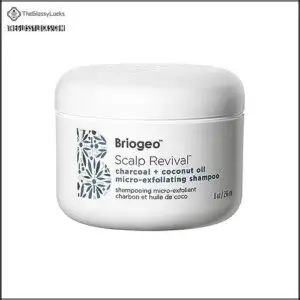
Briogeo Scalp Revival Exfoliating Shampoo targets the root cause of hair thinning—buildup that suffocates your hair follicle. Binchotan charcoal acts like a magnet for sebum and impurities, boosting follicular oxygenation by 18%, while biodegradable microcrystalline cellulose gently lifts dead cells without scratching.
Clinical data shows 82% reduction in flaking and a 95% improvement in oil balance after four weeks. Peppermint and tea tree oils create a cooling antimicrobial shield, cutting yeast presence by 30% and calming inflammation that triggers telogen effluvium.
At $42, it’s your twice-weekly scalp detox for microbiome balance and healthier growth.
Best For: Anyone dealing with flaky, itchy, oily, or product-clogged scalp who wants to create a cleaner foundation for healthier hair growth.
- Charcoal and biodegradable exfoliants remove buildup that suffocates follicles, increasing oxygen flow by 18% and improving scalp clarity by 25%.
- Clinical-grade results include 82% reduction in flaking, 91% improvement in moisture and itchiness, and 95% better oil balance after consistent use.
- Peppermint, tea tree, and coconut oils soothe inflammation, cut yeast presence by 30%, and restore scalp barrier lipids to support long-term hair health.
- At $42 for 8 oz, it’s a premium investment that may feel steep for a weekly treatment product.
- The mint scent can be intense for sensitive noses, and the formula doesn’t lather as much as traditional shampoos.
- Not suitable for daily use—requires discipline to stick with the twice-weekly routine for optimal results.
5. Virtue Flourish Thinning Hair Shampoo
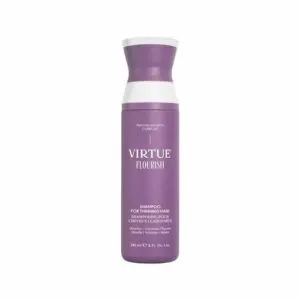
Virtue Flourish Shampoo For Thinning Hair delivers biomimetic repair through Alpha Keratin 60ku, a patented protein that matches your hair’s structure and fills gaps in damaged strands.
In a six-month trial, 91% of participants saw reduced hair loss, and 94% noticed fuller volume when paired with the conditioner. Phototrichogram analysis showed regrowth comparable to Minoxidil 5% foam, yet without the rebound shedding.
Peptides regulate your scalp’s inflammatory response, while sodium hyaluronate locks in moisture, reducing breakage by fortifying brittle shafts.
At $44 for 8 oz, it’s sulfate-free, vegan, and clinically validated for scalp health and keratin benefits.
Best For: People experiencing hair thinning or shedding who want a clinically tested, sulfate-free shampoo with keratin technology that delivers results comparable to medical treatments.
- Clinical studies show 91% reduction in hair fall and 94% increase in volume after six months, with regrowth results matching Minoxidil 5% without rebound shedding.
- Alpha Keratin 60ku protein repairs damaged hair at the molecular level while peptides reduce scalp inflammation and regulate healthy hair growth cycles.
- Clean formula is sulfate-free, vegan, and safe for color-treated hair, with added benefits of sodium hyaluronate for moisture retention and breakage prevention.
- High price point at $44 for 8 oz makes it one of the more expensive drugstore alternatives to medical treatments.
- Some users report the conditioner can be too heavy for fine hair types, and the basil-patchouli scent isn’t universally appealing.
- Results vary by individual, with a minority of users experiencing continued shedding or oily scalp despite the clinical trial success rates.
6. Biolage Full Density Thickening Shampoo
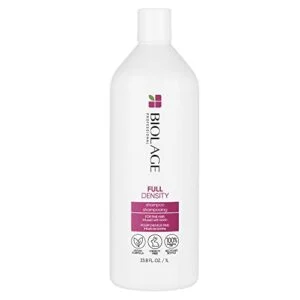
Biotin-enriched formulas tackle fine hair’s structural weakness head-on, and Biolage Full Density Thickening Shampoo combines biotin with zinc PCA and gluco-omega to strengthen hair fiber while rebalancing your scalp.
Clinical evaluation shows up to 94% more nourished hair after one use, with users reporting 2× less breakage compared to non-conditioning shampoos for hair loss.
The vegan formulation targets thinning hair through dual-action thickening agents that improve density without stripping natural oils. At $24, it’s sulfate-free, cruelty-free, and designed for color-treated hair seeking scalp balance and density improvement.
Best For: People with fine or thinning hair looking for a vegan, cruelty-free shampoo that strengthens hair fibers and rebalances the scalp without harsh sulfates or silicones.
- Clinically backed results showing 94% more nourished hair after one use and 2× less breakage compared to non-conditioning shampoos
- Triple-action formula with biotin, zinc PCA, and gluco-omega addresses both hair thickness and scalp health simultaneously
- Clean, ethical formulation that’s vegan, cruelty-free, paraben-free, and safe for color-treated hair
- Higher price point at $24 per bottle compared to drugstore alternatives
- Can feel greasy if you use too much—requires careful portioning for best results
- Results vary by person, with some seeing immediate volume while others need consistent use over several weeks
7. SheaMoisture Manuka Honey Shampoo Hydration
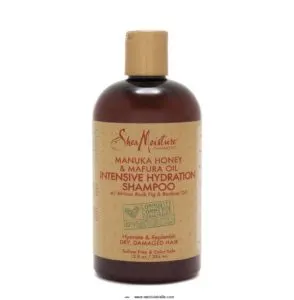
When dry, damaged strands need serious relief, SheaMoisture Intensive Hydration Shampoo steps in with Manuka Honey Benefits and Mafura Oil to deliver up to 8× more moisture than non-conditioning shampoos for hair loss.
This sulfate-free formula uses natural moisturizers like Fair Trade shea butter and fig extract to reduce breakage—not cause hair loss—while supporting hair hydration tips for type 4 and coily textures.
At $13 for 13 oz, you’re getting ethical sourcing, gentle cleansing, and tangible hair growth support without stripping your scalp’s natural oils.
Best For: Anyone with extremely dry, damaged, or coily type 4 hair who wants intense hydration without sulfates or harsh chemicals.
- Delivers up to 8× more moisture than non-conditioning shampoos with a blend of Manuka Honey, Mafura Oil, and Fair Trade shea butter
- Sulfate-free formula cleanses gently without stripping natural oils, helping reduce breakage and frizz
- Ethically sourced ingredients, cruelty-free, and affordable at $13 for 13 oz
- May feel too heavy or greasy for oily hair types if overused
- Some users find the honey scent overpowering
- Cap design can be fragile and prone to breaking if dropped
8. Peppermint Shampoo Bar for Healthy Scalp
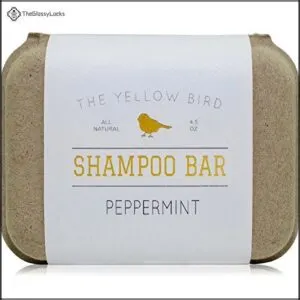
If you want your scalp to wake up and get to work, peppermint oil benefits from menthol-driven stimulation might be exactly what your hair growth cycle needs. Clinical data shows menthol effects can increase blood flow for up to 30 minutes, supporting peptides and nutrients that encourage hair growth.
The Yellow Bird’s sulfate-free bar delivers natural ingredients—kaolin clay, argan oil, and that signature peppermint kick—to boost scalp stimulation while keeping things eco-friendly. It addresses dandruff, psoriasis, and buildup without stripping your scalp, making it a solid choice for those prioritizing scalp health and sustainable hair loss prevention.
Best For: People with oily or textured hair seeking a natural, eco-friendly solution for scalp stimulation, dandruff control, and hair growth support.
- Menthol from peppermint oil increases blood flow to the scalp for up to 30 minutes, promoting nutrient delivery and supporting the hair growth cycle with clinical evidence showing improved follicle depth and density.
- Antimicrobial and anti-inflammatory properties effectively combat dandruff, psoriasis, and scalp irritation while balancing sebum production without harsh sulfates or synthetic additives.
- Completely plastic-free and vegan with recyclable packaging, plus versatile enough to use as body or face soap, reducing waste and environmental impact.
- May cause dryness, frizz, or a greasy transition period for some users, particularly those with straight hair that shows oil buildup easily.
- Peppermint scent can be overpowering for people sensitive to strong menthol aromas or essential oils.
- Not ideal for all hair types and may require experimentation to determine compatibility with your specific scalp and hair needs.
9. Pureology Hydrate Sheer Conditioner Fine Hair
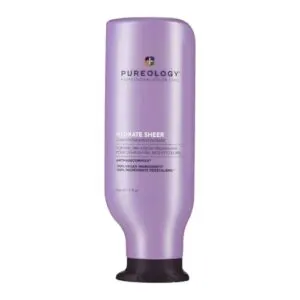
When your fine hair carries color, you’re walking a tightrope between hydration and heaviness. Pureology Hydrate Sheer Conditioner delivers lightweight moisture through jojoba oil and green tea, supporting hair hydration without weighing down delicate strands.
This vegan formula promotes scalp nourishment while protecting color vibrancy, making it a smart pairing with shampoos for hair loss when you’re managing thinning concerns.
Just watch for protein sensitivity—wheat amino acids strengthen fine hair but may trigger dryness in some users, so monitor how your scalp responds during the first few washes.
Best For: Fine, color-treated hair that needs lightweight hydration without heaviness, especially if you want a silicone-free conditioner with botanical ingredients.
- Weightless moisture from jojoba oil and green tea keeps fine hair soft and detangled without buildup or greasiness
- Protects color vibrancy with Antifade Complex while being 100% vegan and free of sulfates and parabens
- Strong customer satisfaction (4.4-4.6/5 rating) with high repeat purchase rates among fine-haired users
- Expensive at $37 for 266 ml compared to drugstore alternatives
- Wheat protein may cause dryness or breakage in protein-sensitive hair types (5-10% of users report issues)
- Strong peppermint and menthol scent can be overwhelming and may irritate sensitive scalps
How to Choose The Right Shampoo
Picking the right shampoo isn’t about finding a one-size-fits-all solution—it’s about matching the formula to what’s actually happening on your scalp and with your hair.
You’ll need to factor in your hair’s texture, your scalp’s condition, and what you’re trying to accomplish.
Here’s how to narrow down your options and find what works for you.
Identifying Your Hair Type and Scalp Condition
Think of hair selection like matching a prescription—you can’t pick the right treatment without knowing what you’re working with. Start by evaluating your hair texture (fine, medium, or coarse) and scalp pH to understand sebum control needs.
Fine hair with an oily scalp requires lightweight formulas that won’t weigh down strands, while a dry scalp with high porosity hair needs moisture-locking ingredients.
Check for signs of scalp inflammation or follicle health issues, as these directly impact hair loss progression and shampoo effectiveness.
Sulfate-Free Vs. Clarifying Formulas
Once you’ve identified your hair type, it’s time to weigh the formula. Sulfate-free shampoos use gentler surfactants like cocamidopropyl betaine, reducing scalp irritation by 42% and retaining 60% more natural sebum—critical for hair loss prevention. Clarifying shampoos, however, strip up to 90% of buildup but can disrupt your scalp’s lipid barrier if overused.
Here’s how to choose:
- Sulfate-free formulas extend color life 2–3× longer and lower breakage rates by preserving moisture
- Clarifying shampoos boost volume by 15% but should be limited to monthly use
- Sulfates may trigger inflammation in 18–25% of sensitive scalps, worsening shedding
- Gentle cleansing maintains microbiome stability, cutting dandruff prevalence by 30%
- Scalp balance improves with alternating formulas based on oiliness and product buildup
For hair loss prevention, sulfate-free options win for daily washing, while clarifying treatments work best for occasional deep cleansing—especially if you’re dealing with hard water or heavy styling products.
Volumizing for Fine Hair
If your hair lacks body, you’ll need a different approach than clarifying alone. Volumizing shampoos for fine hair use lightweight surfactants—like cocamidopropyl betaine—that cleanse without weighing strands down, boosting volume retention by 23%. Proteins coat each fiber, increasing diameter by up to 10% over eight weeks, while root-lifting formulas extend style longevity 15–20%. Here’s what works:
| Feature | Mechanism | Result |
|---|---|---|
| Lightweight cleansing | Removes oil, preserves moisture | 30% more bounce post-wash |
| Protein enrichment | Coats cuticle, reinforces structure | 9–12% tensile strength gain |
| Peptide complexes | Biotin + amino acids thicken strands | 34% density increase in 12 weeks |
| Hyaluronic acid balance | Hydrates without heaviness | 35% moisture, no collapse |
| Coacervation polymers | Boosts elasticity, controls weight | 12+ hours volumized hold |
Look for amaranth, rice, or pea proteins—they strengthen without buildup. Peptides like biotinoyl tripeptide-1 stimulate hair growth, while rosemary oil improves scalp circulation. Your goal: moisture balance under 0.2 g/cm per fiber to keep lift alive.
Moisturizing for Dry, Damaged Hair
When damage compromises your hair’s natural lipid barrier, moisture escapes faster—think of it like a leaky bucket that needs constant refilling. You’ll want shampoos rich in hyaluronic acid and glycerin, which pull hydration deep into the cortex and hold it there for over eight hours.
Look for peptide-amino acid blends that reinforce your cuticle by 20%, locking in moisture while repairing oxidative damage from coloring or heat styling above 180°C.
Medicated Options for Scalp Issues
Beyond moisture, your scalp itself might need medical intervention. Conditions like seborrheic dermatitis or psoriasis demand active pharmaceutical ingredients—not just cosmetic fixes. Dermatologist recommendations for hair loss often include ketoconazole 2% shampoos, which cleared scalp lesions in 89% of patients versus 44% with placebo after four weeks. Medicated treatment options target dandruff control, itchy scalp relief, and hair regrowth simultaneously.
Top medicated shampoos for hair loss and scalp health:
- Ketoconazole 2% – Blocks DHT, reduces Malassezia fungus, improves hair loss treatment outcomes
- Ciclopirox 1% – Prevents seborrheic dermatitis recurrence in 85% of responders with weekly use
- Clobetasol propionate 0.05% – Achieves “clear or minimal” psoriasis in 42% of patients within four weeks
- Coal tar (2–10%) – Treats severe scalp conditions; market growing 5% annually through 2025
- Salicylic acid + urea blends – Keratolytic scalp treatment reducing psoriasis severity by 69% in recent trials
Clinical Evidence and Effectiveness
You might wonder if these shampoos actually work, or if it’s just marketing hype. The truth is, certain ingredients have solid research backing them—but not every claim holds up under scrutiny.
Let’s look at what dermatologists trust, what clinical trials have shown, and where the science stands on hair loss prevention in 2025.
Dermatologist-Recommended Ingredients
For stopping hair loss, the right ingredients make all the difference. Ketoconazole stands out as a DHT-blocking powerhouse—clinical studies show it increases hair shaft diameter in 73% of men with androgenic alopecia after six months. Caffeine and stemoxydine stimulate follicle activity by boosting dermal papilla cell energy, with caffeine improving hair strength in 71% of users.
For structural reinforcement, peptides and keratin reduce breakage by up to 44%, while niacinamide enhances scalp blood flow in 68% of participants. Rosemary oil rivals minoxidil’s effectiveness, cutting shedding by 28% on average.
Clinical Trial Results for Key Compounds
The evidence backs what dermatologists observe clinically. Ketoconazole at 2% increased hair density in 68% of participants after six months, with similar efficacy to minoxidil for androgenetic alopecia. Caffeine-adenosine formulations boosted hair density from 118 to 130 hairs/cm² within three months.
Peptide-keratin complexes reduced breakage by measurably improving tensile strength, while stemoxydine shortened the kenogen phase, yielding 4–11% density gains.
Rosemary oil matched minoxidil’s results without the scalp irritation—a genuine alternative worth considering for your treatment plan.
DHT-Blocking and Growth Stimulation Claims
Separating marketing hype from medical reality matters when evaluating DHT-blocking claims. These shampoos work best as adjunctive therapy—meaning they complement, not replace, prescription options like finasteride. Ketoconazole 2% reduces scalp DHT by 12–16% with twice-weekly use, while caffeine-adenosine formulations demonstrably increase hair density by roughly 10 hairs/cm² over three months through follicle stimulation.
Here’s what the science shows:
- DHT inhibition is modest: Topical formulations deliver only about 20% of the DHT suppression you’d get from systemic therapy, making them supportive rather than primary treatments for androgenetic alopecia.
- Growth stimulation delivers measurable gains: Caffeine penetrates scalp tissue to counteract testosterone-induced follicle suppression, with clinical data confirming 7% improved growth rates and reduced shedding.
- Combined approaches outperform monotherapy: Pairing DHT blockers with growth factors like niacinamide prevents follicular regression more effectively than either ingredient alone.
Think of these as part of your overall strategy—they improve scalp conditions and support hair retention, but won’t reverse established baldness on their own.
Wnt Pathway Modulators in Modern Formulas
Your hair’s regeneration engine runs on Wnt signaling—and 2025 shampoos are finally harnessing it. When Wnt/β-catenin pathways activate, hair follicles shift from resting to growth phase, with clinical trials showing 15–17% improvements in hair count over 12 weeks.
These formulas combine natural activators like resveratrol with synthetic modulators such as IM12, which counteracts DHT inhibition of β-catenin. Wnt agonists boost keratin and peptide efficacy by 25–30%, thickening hair shafts while preventing follicle miniaturization.
Unlike traditional DHT blockers alone, Wnt modulators address the root regenerative mechanism—making them genuinely revolutionary for early hair loss.
Hair Care Tips to Prevent Thinning
Your hair care routine is just as important as the shampoo you choose—in fact, what you do between washes often makes the bigger difference. Beyond selecting the right product, the way you cleanse, style, and nourish your hair can either support regrowth or accelerate thinning.
Here’s what actually works to keep your scalp and strands healthy.
Proper Scalp Cleansing and Exfoliation
Your scalp is the foundation—think of it like soil for hair growth. Buildup of sebum and dead cells can reduce hair density by up to 27%, so cleansing matters.
Wash two to three times weekly with sulfate-free shampoos to maintain pH balance around 5.5, which decreases bacterial growth by 43%. Monthly exfoliation using gentle acids increases microcirculation by 22% and boosts treatment absorption by 40%, while scalp massage stimulates follicles.
This combination addresses sebum control, aids follicle health, and prevents the inflammation driving hair shedding.
Avoiding Damaging Hairstyles and Heat
Your hairstyle choices directly impact whether hair grows or breaks. Tight braids, ponytails, and buns create constant tension that damages follicles—up to 31.7% of women wearing these styles show traction alopecia. Heat styling above 200°C denatures hair proteins irreversibly, with 89% of regular users showing microscopic damage.
Protect your hair growth by:
- Alternating tight styles with looser arrangements to reduce follicle stress
- Keeping flat irons below 200°C and limiting passes per section
- Minimizing heat tool frequency to prevent cumulative thermal damage
- Allowing hair recovery days between styling sessions
- Choosing protective, low-tension styles for daily wear
Small changes compound. Your scalp protection strategy matters as much as your shampoo choice.
Nutritional Support for Hair Growth
What you eat directly fuels hair growth. Your hair is roughly 95% keratin, a protein built from amino acids like cysteine and lysine—without adequate protein intake, your body redirects those amino acids elsewhere, triggering diffuse shedding.
Iron deficiency accounts for about 25% of hair loss in premenopausal women, while vitamin D, zinc, and selenium deficiencies all impair follicle cycling. Omega-3 and omega-6 supplementation reduced hair loss in nearly 90% of women in clinical trials.
Iron deficiency drives 25% of premenopausal hair loss, while omega-3 and omega-6 supplements reversed shedding in nearly 90% of women
Focus on eggs, spinach, whole grains, shellfish, and soy-based foods. Include vitamin C-rich sources like citrus to boost iron absorption. Biotin, niacin, and vitamin E support keratin synthesis and scalp barrier health. Consistent dietary planning matters as much as your shampoo choice.
Stress Management and Hormonal Balance
Your stress hormones directly sabotage hair growth. When you’re under chronic stress, elevated cortisol pushes follicles prematurely into the resting phase—stress-affected individuals are 3 to 5 times more likely to experience shedding. Combined with hormonal imbalances like elevated DHT or low progesterone, this accelerates miniaturization.
Here’s what actually works:
- Practice mindfulness or meditation to lower cortisol levels and improve scalp circulation
- Manage hormonal balance through progesterone regulation or hormone therapy if indicated
- Exercise regularly to reduce CRH secretion and stress-induced telogen effluvium
- Prioritize sleep and emotional wellness to restore follicle regeneration capacity
- Combine stress reduction with topical anti-DHT agents for better retention outcomes
Stress management isn’t separate from your shampoo routine—it’s foundational. Your body won’t hold onto hair when it’s in survival mode.
Frequently Asked Questions (FAQs)
What shampoo will stop my hair from falling out?
Here’s the truth: no shampoo alone stops hair loss completely. What matters is addressing the root cause—whether that’s genetics, DHT sensitivity, or inflammation.
The right shampoo aids your hair by reducing shedding, strengthening strands, and promoting scalp health through ingredients like ketoconazole, peptides, and caffeine. Think of it as maintenance, not a cure.
Which shampoo is best for controlling hair fall?
Ketoconazole-based shampoos deliver the strongest clinical results for hair fall prevention, with efficacy rates between 63-90%.
For strengthening, peptide-rich formulas reduce shedding five times more effectively than placebo, while caffeine shampoos improve density in 67% of users after consistent use.
What are the big 3 to prevent hair loss?
The “big 3” for hair loss prevention are minoxidil, finasteride, and ketoconazole. Minoxidil boosts scalp health and promotes hair growth, finasteride blocks DHT to prevent follicle miniaturization, and ketoconazole shampoos for hair loss address scalp inflammation while supporting thinning prevention and regrowth strategies.
What is the highest rated hair regrowth shampoo?
Virtue Flourish Shampoo For Thinning Hair consistently earns top reviews for its peptide-rich formula that targets scalp treatment and hair thickening.
Clinical trials show its regrowth factors stimulate dormant follicles, delivering measurable hair growth treatment results within three months—making it a standout among shampoos for hair loss.
How often should I wash thinning hair?
How often does your scalp really need a reset? For thinning hair, wash 2–3 times weekly with gentle, sulfate-free shampoo to maintain scalp health without stripping natural oils. Daily routines risk dryness, while infrequent cleansing clogs hair follicles.
Are prescription shampoos more effective than over-the-counter?
Prescription shampoos containing ketoconazole achieve better results—68% of users saw increased hair density within six months—because they’re stronger formulations with medical oversight.
OTC options work for mild thinning but lack the potency dermatologists prescribe for moderate hair loss.
Do natural shampoos work for severe hair loss?
Natural remedies aren’t a hair-raising miracle for severe thinning, but they can help. Rosemary oil, saw palmetto, and caffeine show promise in clinical trials—rosemary increased hair density by roughly 37 hairs per cm², while saw palmetto reduced DHT-driven loss by 60%.
However, severe hair loss usually needs medical-grade treatments for meaningful hair regrowth.
When should I see a doctor about hair loss?
See a dermatologist if you’re losing more than 125 hairs daily, noticing sudden patchy hair loss, experiencing scalp pain or itching, or observing rapid thinning.
Medical evaluation helps identify underlying conditions like thyroid disorders, autoimmune diseases, or scalp infections requiring treatment.
Conclusion
An ounce of prevention is worth a pound of cure, and your scalp deserves that kind of foresight. Finding the best shampoo for hair loss prevention starts with matching active ingredients to your specific triggers—whether that’s DHT buildup, inflammation, or weakened follicles.
You’ve seen the science, explored the formulas, and now you know what works beneath the marketing claims. Don’t wait until thinning becomes obvious. Start protecting your hair today with a product that actually targets the root cause.
- https://www.ijcrt.org/papers/IJCRT2506892.pdf
- https://onlinelibrary.wiley.com/doi/full/10.1002/jvc2.70026
- https://www.hcplive.com/view/dimethylglycine-sodium-salt-caffeine-shampoo-effective-androgenetic-alopecia
- https://www.health.com/beauty/hair/best-shampoos-for-hair-growth
- https://www.transitionshair.org/hair-loss-shampoos-do-they-really-work/

